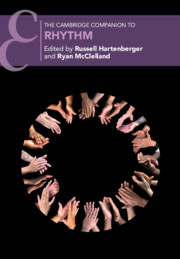65 results
Introduction
-
-
- Book:
- The Cambridge Companion to Rhythm
- Published online:
- 18 September 2020
- Print publication:
- 24 September 2020, pp 1-4
-
- Chapter
- Export citation
5 - A Different Kind of Virtuosity
- from Part II - Performing Rhythm
-
-
- Book:
- The Cambridge Companion to Rhythm
- Published online:
- 18 September 2020
- Print publication:
- 24 September 2020, pp 75-89
-
- Chapter
- Export citation
Acknowledgments
-
- Book:
- The Cambridge Companion to Rhythm
- Published online:
- 18 September 2020
- Print publication:
- 24 September 2020, pp xxv-xxvi
-
- Chapter
- Export citation
Music Examples
-
- Book:
- The Cambridge Companion to Rhythm
- Published online:
- 18 September 2020
- Print publication:
- 24 September 2020, pp xv-xviii
-
- Chapter
- Export citation
Part III - Composing with Rhythm
-
- Book:
- The Cambridge Companion to Rhythm
- Published online:
- 18 September 2020
- Print publication:
- 24 September 2020, pp 95-164
-
- Chapter
- Export citation
Index
-
- Book:
- The Cambridge Companion to Rhythm
- Published online:
- 18 September 2020
- Print publication:
- 24 September 2020, pp 335-344
-
- Chapter
- Export citation
Part IV - Rhythm in Jazz and Popular Music
-
- Book:
- The Cambridge Companion to Rhythm
- Published online:
- 18 September 2020
- Print publication:
- 24 September 2020, pp 165-214
-
- Chapter
- Export citation
Copyright page
-
- Book:
- The Cambridge Companion to Rhythm
- Published online:
- 18 September 2020
- Print publication:
- 24 September 2020, pp viii-viii
-
- Chapter
- Export citation
Figures
-
- Book:
- The Cambridge Companion to Rhythm
- Published online:
- 18 September 2020
- Print publication:
- 24 September 2020, pp xi-xii
-
- Chapter
- Export citation
Tables
-
- Book:
- The Cambridge Companion to Rhythm
- Published online:
- 18 September 2020
- Print publication:
- 24 September 2020, pp xiii-xiv
-
- Chapter
- Export citation
Select Bibliography
-
- Book:
- The Cambridge Companion to Rhythm
- Published online:
- 18 September 2020
- Print publication:
- 24 September 2020, pp 331-334
-
- Chapter
- Export citation
Part V - Rhythm in Global Musics
-
- Book:
- The Cambridge Companion to Rhythm
- Published online:
- 18 September 2020
- Print publication:
- 24 September 2020, pp 215-312
-
- Chapter
- Export citation
Contents
-
- Book:
- The Cambridge Companion to Rhythm
- Published online:
- 18 September 2020
- Print publication:
- 24 September 2020, pp ix-x
-
- Chapter
- Export citation
Part I - Overview of Rhythm
-
- Book:
- The Cambridge Companion to Rhythm
- Published online:
- 18 September 2020
- Print publication:
- 24 September 2020, pp 5-38
-
- Chapter
- Export citation
Part II - Performing Rhythm
-
- Book:
- The Cambridge Companion to Rhythm
- Published online:
- 18 September 2020
- Print publication:
- 24 September 2020, pp 39-94
-
- Chapter
- Export citation
Part VI - Epilogue
-
- Book:
- The Cambridge Companion to Rhythm
- Published online:
- 18 September 2020
- Print publication:
- 24 September 2020, pp 313-330
-
- Chapter
- Export citation
Notes on Contributors
-
- Book:
- The Cambridge Companion to Rhythm
- Published online:
- 18 September 2020
- Print publication:
- 24 September 2020, pp xix-xxiv
-
- Chapter
- Export citation

The Cambridge Companion to Rhythm
-
- Published online:
- 18 September 2020
- Print publication:
- 24 September 2020
2 - Percussion and Drumming
-
- Book:
- Performance Practice in the Music of Steve Reich
- Published online:
- 13 October 2016
- Print publication:
- 06 October 2016, pp 29-32
-
- Chapter
- Export citation
10 - Performance practice in Drumming
-
- Book:
- Performance Practice in the Music of Steve Reich
- Published online:
- 13 October 2016
- Print publication:
- 06 October 2016, pp 108-152
-
- Chapter
- Export citation



